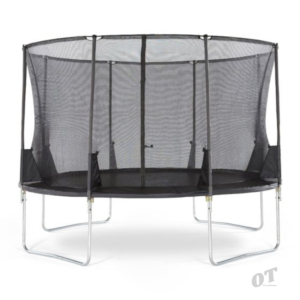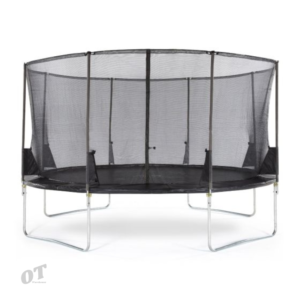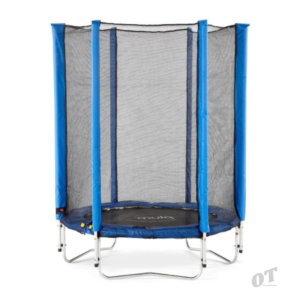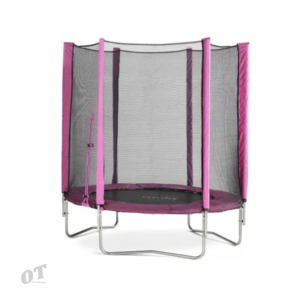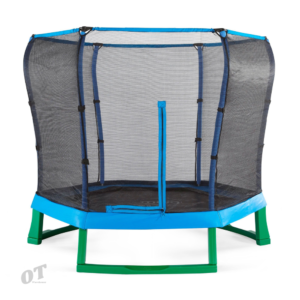What are trampolines used for?
Trampolines are often used as a recreational play activity for children and adults. They can be used in gymnastics, diving, and other sports. They are also used in physical therapy and as a training tool.
A family with a trampoline is almost a given in Australia. They are that popular. Children and adults can flip, jumping, somersault, and tumbling, and bounce in their own backyard.
Not only can a trampoline be great fun, but it can also be good to use energy, helping with cardiovascular health,
Plyometric exercises are a great way to improve your cardiovascular health and have some fun at the same time and will burn calories.
How are trampolines made?
The materials for a trampoline are made of steel, polypropylene, and rubber. The steel is used for the frame, polypropylene is used for the mat, and rubber or spring steel is used for the springs.
The frame of a trampoline is made by welding together steel tubes. The tubes are then covered with a polypropylene fabric. The fabric is then stitched to the frame with steel cables.
Some playgrounds have a large trampoline park with inground inflatable mats. They are filled with air and are a whole lot of fun.
also available is springless trampolines which is a readily available product here in Australia.
Where is the best place to put a trampoline?
The best place to put it is in an open area on level ground. If you have grass, the trampoline can be placed directly on the ground. If you have a deck or patio, you may want to place the trampoline on a trampoline mat to protect the surface beneath. You'll also want to make sure there are no obstacles nearby that could potentially damage the trampoline or injure someone using it.
Facts:
1. A trampoline is a piece of equipment consisting of a piece of taut, strong fabric stretched over a steel frame using coiled springs.
2. The fabric is not elastic.
3. The frame is made of steel tubing.
4. The springs are made of steel or elastic rubber.
5. Trampolines are used for recreational and competitive purposes.
6. They are also used in gymnastics, diving, and other sports.
7. Trampolines were originally used as a training tool for acrobats and circus performers.
8. The first modern trampoline was built in 1936 by George Nissen and Larry Griswold.
9. Trampolines are now manufactured in a variety of sizes and shapes.
10. The largest trampoline in the world is in New Zealand and is 50 meters in diameter.
what are some accessories
Trampoline accessories can range from netting enclosures to padding over the springs, but there is also ladders to help climb inside,
Trampoline anchor kits to stop the trampoline moving from the ground.
shoe bags to place whilst kids are jumping.
Other play equipment are basketball rings, and creating your own wet park.
What are the dimensions and design of a trampoline?
Trampoline is very popular in society today, and there is plenty of manufacturers, each having their own designs. At otwarehouse our largest tramp is 14ft then there is a series of 7ft, 6ft, 4.5tf.
A trampoline is an apparatus consisting of a piece of taut, strong fabric stretched between a metal frame using many coiled springs. People bounce on trampolines for recreational and competitive purposes. The fabric that users bounce on is not elastic, as one might expect, but rather has a very strong weave that does not stretch. The fabric is attached to the frame with V-rings, and the springs attach to the frame with hooks.
What is the weight limit for a trampoline?
A trampoline will vary depending on the make and model of the trampoline, as well as the quality of the materials used in its construction. However, as a general rule of thumb, most trampolines will have a weight limit of around 115kg for larger. This means that the trampoline should be able to safely support the weight of one adult person.
Safety weight limit for a trampoline
- 4.5ft trampoline weight limit is 45kg kids
- 6ft wide trampoline weight limit is 55kg for a child.
- 7ft wide trampoline weight limit is 55kg for kids
- 8ft wide trampoline weight limit is 78kg
- 10ft wide trampoline weight limit is 78kg
- 12ft wide trampoline weight limit is 128kg
- 14ft trampoline is 127kg for adults
How much does a trampoline weigh?
A trampoline typically weighs between 20 and 45kg. The weight of a trampoline will depend on the size and construction of the trampoline. A small, round trampoline may weigh as little as 20kg, while a large, rectangular trampoline may weigh up to 45kg.
What is the height limit for a trampoline?
Different manufacturers use different heights such as the type and size of the trampoline, the weight and height of the user, and the level of experience of the user.
Height of a trampoline
- 4.5ft trampolinee height is 185cm
- 6ft trampoline height is 205cm
- 7ft trampoline height is 205cm
- 8ft trampoline height is 217cm
- 10ft trampoline height is 255cm
- 12ft trampoline height is 255cm
- 14ft trampoline height is 255cm
How much does a trampoline cost?
The cost of a trampoline depends on a few factors, such as the size and quality of the trampoline. A small, basic trampoline might cost around $200, while a large, high-quality trampoline could cost $2000 or more. their is also a range of accessories that can be adapted to different products.
What is the warranty for a trampoline?
Most trampolines come with some sort of warranty that covers defects in materials and workmanship. These warranties typically last for a year, though some may be longer. Additionally, many retailers offer their own extended warranties for an additional cost.
How often should a trampoline be replaced?
How often a trampoline should be replaced depends on many factors, such as how often it is used, how many people use it, how heavy they are, what the weather is like, etc. If you live in an area with a lot of sun, your trampoline will probably degrade faster than if you live in a cooler climate. Placing it undercover or with a shade sail above it extends the life of the product.
Statistics:
1. The average trampoline is 42 inches in height and has a weight limit of 115kg.
2. A typical rectangular trampoline is 14 feet long and 8 feet wide.
3. Trampolines have been around for over 2,000 years.
4. The first modern trampoline was invented in 1936 by George Nissen and Larry Griswold.
5. Trampolines are used in gymnastics, diving, and freestyle skiing.
6. They are also used for recreational purposes.
7. Trampolines can be dangerous if not used properly.
8. In 2009, there were 3,455 trampoline-related injuries in Australia.
9. Most trampoline-related injuries occur when multiple people are using the trampoline at the same time.
What is the best way to store a trampoline?
The best way to store it is to first remove the legs and springs. Once these are removed, you can fold the trampoline in half and then in half again so that it forms a smaller square. If you have a round trampoline, you can first remove the legs and then fold it in half. Once it is folded in half, you can then twist it so that it forms a smaller circle. this is great when you are moving house.
What is the best way to clean a trampoline?
The best way to clean a trampoline is to first remove any debris such as leaves or sticks that may be on the surface. Next, using a garden hose, spray down the entire trampoline to wet it. Then, using a mild soap, scrub the surface of the trampoline with a soft brush. Do not clean with a pressure hose as this impacts the life of the stitching.
Are trampolines safe?
Yes, trampolines are safe when used correctly. However, there are some safety concerns that you should be aware of.
When used correctly, trampolines are a great way to get exercise, have fun, and develop coordination and balance. However, there are some safety concerns that you should be aware of.
Trampolines can be dangerous if used incorrectly. The most common injuries are broken bones, sprains, and strains.
Where can I buy a trampoline?
There are many places where you can buy a trampoline. You can purchase one at a store that specializes in selling trampolines or at a general sporting goods store. You can also find them online. When purchasing a trampoline, you will want to consider the size, weight limit, and warranty. You will also want to decide if you want a round or rectangular trampoline. Otwarehouse has partnered with some of the best trampoline and swing set manufacturers in Australia, the price will vary between brands.

